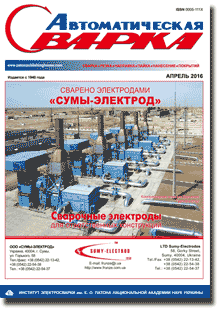| 2016 №04 (07) |
DOI of Article 10.15407/as2016.04.01 |
2016 №04 (02) |

Avtomaticheskaya Svarka (Automatic Welding), #4, 2016, pp. 9-25
Extension of the life of GTK 10-4 working blades from EI 893 alloy after long operating period
A.F. Belyavin1, V.V. Kurenkova1, D.A. Fedotov1, S.G. Saly2 and A.P. Shcherbinin2
1«Paton Turbine Technologies» Ltd. 26 Raketnaya Str., 03028, Kiev, Ukraine. E-mail: VKurenkova@patontt.com
2Repair Enterprise «Ukrgazenergoservis», Subdivision of PJSC «Ukrtransgaz» of NJSC «Naftogaz Ukrainy» 49 Mayakovsky Str., 08151, Boyarka, Ukraine
Abstract
During prolonged operation (thousands of hours) degradation of base material — EI 893 alloy — proceeds in working blades of GTK 10-4 unit under the impact of static and dynamic loads, temperature gradient, fuel combustion products, etc. Structural changes in the basic blade alloy influence the changes of its mechanical properties, compared to metal in initial state, namely, increase of ultimate strength, yield limit, hardness values and lowering of ductility characteristics take place and, therefore, also lowering of their creep resistance and high-cycle fatigue. For this reason, extension of service life of expensive items in turbine hot section is an extremely important task, which is solved by integrated restoration of initial structure and mechanical properties of EI 893 alloy. The objective of this work was studying GTE material state after operational aging on seven working blades (from sets with different operating lives), determination of their repairability and selection of modes of recovery heat treatment. It was found that during long operation periods at the temperature of 630–670 oC an essential change of structural-phase state of base material proceeds in the working blades, which is manifested in dissolution, coagulation and non-uniform distribution of strengthening phase in matrix solution volume and carbide precipitation on subgrain boundaries within the grains and on grain boundaries, and formation of carbides of a more complex composition. It was established that optimum base structure with sufficient hardness and microhardness forms at two-step recovery heat treatment, namely, a certain reduction of difference in grain dimensions (mainly, 2–4 grain size point), reduction of density and dimensions of stable carbide phases in intergranular interlayers, and uniform and regular distribution of disperse strengthening phase. Structure recovery after recovery heat treatment leads to improvement of ductile characteristics (δ = 33.2–35.6 %) and, consequently, also of fatigue resistance at admissible values of strength and fracture toughness, that, on the whole, ensures the serviceability of reconditioned items. 16 Ref., 5 Tables, 10 Figures.
Keywords: high-pressure turbine (HPT), low-pressure turbine (LPT), recovery heat treatment (RHT), hardness, microhardness, ultimate strength, yield limit, ductility, fracture energy, deposited weld, heat-affected zone
Received: 30.12.2015
Published: 02.06.2016
References
1. Verin, A.D., Sims, C.T., Hagel, W.C. (1976) Microstructure and properties of heat-resistant alloys. In: Heat-resistant alloys. 207–241. Moscow: Metallurgiya.
2. Getsov, L.B. (1996) Materials and strength of gas turbine parts. Moscow: Nadra.
3. Majner, R.V. (1995) Fatigue. Superalloys II. Heat-resistant materials for aerospace and industrial power plants, Vol. 1, 336–372. Moscow: Metallurgiya.
4. Nemajzer, Yu.A., Gursky, G.L., Dobina, N.I. et al. (1982) Influence of grain size on structural fatigue strength of blades from KhN65VMTYu (EI 893) alloy. Energomashinostroenie, 5, 18–21.
5. Pigrova, G.D., Kabanov, B.S., Sedov, V.M. (2002) Method of physico-chemical phase analysis for evaluation of structural state of heat-resistant materials in life prediction. Trudy NPO TsKTI, Issue 289, 39–47.
6. Shajdak, B.P., Ivanov, S.A., Ivanov, A.V. et al. (2002) Prolongation of service life of blades of drive gas turbine units. Service life and reliability of materials and welded joints of power plants. Ibid., 191–204.
7. Berdnik, O.B., Tsaryova, I.N., Razov, E.N. (2011) Development of technology for prolongation of life of KhN65VMTYu alloy turbine blades. Vestnik SamarGAKU, 27(3), 240–246.
8. Pigrova, G.D. (2006) Diagnostics of structural changes in metal of GTU parts during operation by the method of phase physico-chemical analysis. Trudy NPO TsKTI, Issue 295, 55–64.
9. (2005) Development of procedure for prolongation of the life of GTK 10-4 GPU (HPT) 1st stage blades and specifying the life of repaired BKF-05 set: Report of RC Pratt & Whitney Paton. Kiev.
10. Rybnikov, A.I., Kryukov, I.I. (2006) Carbide transformations in intergranular interlayers of heat-resistant nickel-base alloys during ageing and long-term operation. Trudy NPO TsKTI, Issue 295, 154–163.
11. Rybnikov, A.I., Shajdak, B.P., Ivanov, S.A. (2006) Influence of structural factor on structural fatigue strength of blades of stationary GTU. Ibid., 79–90.
12. Getsov, L.B. (2010) Materials and strength of gas turbine parts, Vol. 1. Rybinsk: Gasoturb. Technologii.
13. Fridman, Ya.B. (1974) Mechanical properties of metals, Vol. 2. Moscow: Mashinostroenie.
14. Sorokin, V.G., Guzanov, B.N., Kositsyn, S.V. et al. (1980) Study of EI 893 alloy blades after long-term operation in gas turbine unit. Energomashinostroenie, 3, 25, 26, 29.
15. (2000) Instructions on investigation of causes of blading fracture of gas turbine units in gas-pumping units. Moscow: Gazprom, VNIIGAZ.
16. (2005) Analysis of causes of spontaneous fracture of GTK 10-4 unit HPT 1st stage blades, CS Berdichev (after 78,000 h of operation): Report of RC Pratt & Whitney Paton. Kiev.
